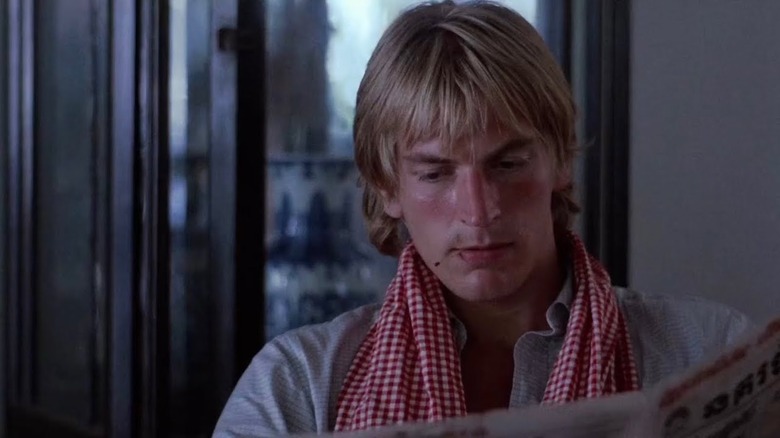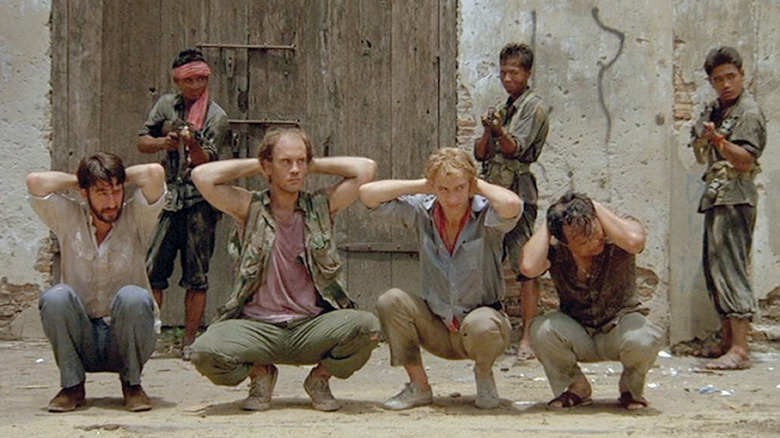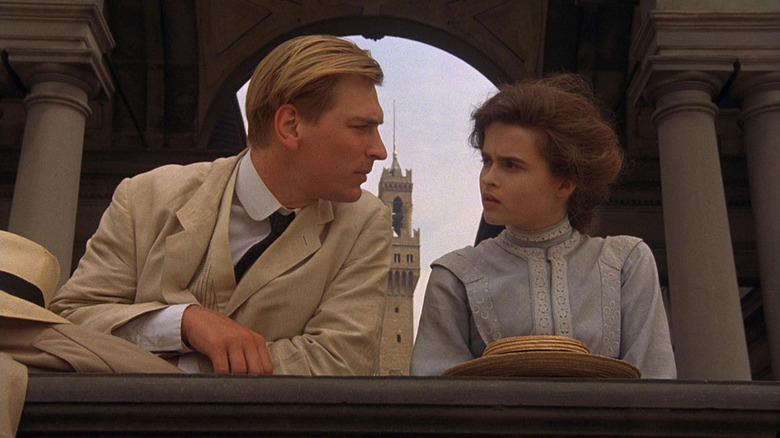Julian Sands Went Through Rigorous Preparation For His Role In The Killing Fields
Few films can match the soul-scarring power of Roland Joffé's "The Killing Fields." Based on the reporting of New York Times journalist Sydney Schanberg, the movie gives viewers an unflinching look into the atrocities committed by the Khmer Rouge as they seized power in Cambodia during the mid-1970s. It's searing stuff, but it really hits home because Joffé, working from a terrific screenplay by Bruce "Withnail and I" Robinson, centers the action on the friendship between Shanberg (Sam Waterston) and Cambodian journalist/interpreter Dith Pran (Haing S. Ngor). In doing so, he's able to explore a broader, professional camaraderie that includes combat photographers Al Rockoff (John Malkovich) and Jon Swain (Julian Sands). They're a colorful, occasionally carousing lot, but their survival is contingent on sticking together.
We see this early in "The Killing Fields," when the various journos pool their resources to create a fake British passport for Pran, who will almost certainly be killed if he's handed over to the Khmer Rouge. It's a tense, yet lovely moment in the movie, one that I've always associated with Sands' charismatic portrayal of the rakish Swain. It's a beguiling prelude to his lushly romantic performance as George Emerson in James Ivory's "A Room with a View," and Sands credits Joffé's process with drawing this memorable turn out of him.
Assembling a cast of inexperienced professionals
In a 2014 interview with The Guardian, Julian Sands, who was 24 when he made "The Killing Fields," recalled Roland Joffé's passion for genuine human emotion. "He was looking to put together a troupe of actors without much film experience," said Sands, "Because he wanted the freshness of everything to resonate with us. He would gather lots of us in his office to improvise scenes."
The film was shot in Bangkok, but Joffé made sure his actors spent time in a Cambodian refugee camp. There, they could obtain first-hand accounts of the monstrous genocide committed by Pol Pot's Khmer Rouge minions. "Atmospherically, intellectually, and culturally, we were marinated," said Sands.
But while Joffé valued authenticity, he worried about Sands spending too much time with Jon Swain, who was on set, per Sands, "taking photographs of me taking photographs of him." There was, in this case, such a thing as getting too close to one's real-life inspiration, but Sands eventually disobeyed Joffé's desires.
Sands and Swain: Pinter-misquoting BFFs
Jon Swain, who began covering the wars in Indochina when he was a mere 22 years old (he'd dropped out of boarding school as a teenager and joined the French Foreign Legion), possessed an anti-authoritarian streak. But once Julian Sands started hanging out with the journo, they became fast friends. As the actor told The Guardian:
"I'd been cautioned by Roland [Joffé'] to keep my distance from Jon because he was an unstable character. And Jon had been told by Roland to stay away from me, because I was a refined, sensible person who didn't want to be distracted. In fact, we bonded instantly. We were always quoting and misquoting Pinter to one another."
Most of my closest friendships involve the quoting and misquoting of Pinter (and Beckett... and Stoppard... and "Diff'rent Strokes..."), so I'm glad Sands flouted Joffé's wishes. He's magnificent as Swain in "The Killing Fields," and, after "A Room with a View," appeared poised to become a major movie star. I'm not sure why he got typecast as sneering twits in Hollywood fare like "Vibes" and "Arachnophobia." He did score a Direct-to-Video franchise out of "Warlock," which, while fun, felt beneath him the longer it dragged on.
Sands should've been one of our great romantic leads, but the industry had other plans for him. Still, many actors would give away their entire career for one George Emerson, so Sands did quite alright. He was a bright, blindingly beautiful light.


